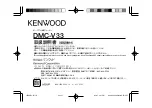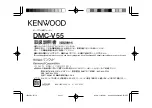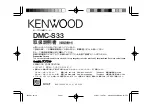
7
䡵
If this camera or cable connected this unit is
used near a location where strong electrical
or magnetic waves are generated (eg. radios,
TVs, transformers, monitors, etc.), noise
interference may occur in the image or its
color may be affected.
䡵
When the AGC circuit is on, brightness of
the screen may not change upon switching
the Auto Iris mode (Normal, + or -) using the
V.Networks Controller. This is due to the
automatic gain boost feature that is activated.
In this case, set AGC to OFF or use the
manual iris mode.
䡵
Under cer tain brightness conditions,
switching the Auto Iris mode (Normal, + or -)
using the V.Networks Controller may not bring
about any change in brightness. In this case,
set the iris to the manual mode.
䡵
When this camera is used in the White Balance
(ATW) mode, the colors captured may differ
slightly from the actual colors due to the
operational principles of the auto-tracking
white balance circuit. This is not a malfunction.
䡵
When shooting a bright object (eg. lamps,
etc.), white vertical streaks may appear on
the object on the screen. This is a
phenomenon (smear phenomenon) normal
to CCDs (solid-state image pickup devices)
and is not a malfunction.
䡵
When the camera is used to monitor the
same position over prolonged hours (such
as 24 hours of continuous monitoring),
contact resistance of the panning mechanism
may increase. This may cause noise
interference in the image or unstable
operation of the V.Networks Controller. To
prevent this from occurring, turn the power
of the system off and on again (to initialize
camera) once a week and clean the contacts.
䡵
The dome cover is hemispherical in shape, and
therefore images tend to be distorted at the
edges of the hemisphere. The edges of the
hemisphere is masked for this camera. When
the camera is tilted and pointed in the horizontal
direction, therefore, edges of the hemisphere
may enter the angle of view, hence causing
the upper end of the screen to appear dark
and the image to go out of focus.
䡵
When shooting an object that is near a light
source (eg. lightings) or with a large
difference in brightness, ghosting may occur
on the screen. This phenomenon is due to
the characteristics of the dome cover and
built-in lens and is not a malfunction.
䡵
Ensure to use the Converter Unit that has
been supplied.
䡵
When playing back images by connecting a
coaxial cable to the VIDEO OUT terminal,
the image on the screen may appear shaky
(rotational motions are not smooth) when
using the Manual or Auto Pan operation
par ticular ly near the Tele end. This
phenomenon is due to the characteristics of
the motor and is not a malfunction.
䡵
Certain hubs/switches that are equipped with
the SNMP feature may come with a broadcast
or multicast control function. Proper viewing
of multicast images created by this camera
may not be possible if this function is enabled.
䡵
Do not touch the dome cover with your hand.
This may dirty the cover and cause the image
quality to deteriorate.
䡵
To clean the camera.
• Do so upon turning off the power.
• Use a lens cloth (or paper) to remove dirt
from the dome cover. The camera may
acquire dirt over a short period of time,
depending on the environment of use.
When there is excessive dirt, wipe using a
lens cloth (or paper) upon wetting it in a
neutral detergent diluted with water.
䡵
Do not connect cameras other than VN-C655
to the ceiling mount. Doing so may cause the
camera to malfunction.
䡵
Consumable Parts
The following parts are consumable. Please
replace them accordingly after a certain number
of hours or count of operations. The service lives
given below are only reference values and may
vary according to the operating environment and
conditions. Note that replacement of consumable
parts is chargeable even within the warranty period.
• Zoom lens assembly
Zooming operation : 2 million times
Focusing operation : 4 million times
• Slip rings
: Approx. 5 million
operations
• Cooling fan
: Approx. 30,000 hours
䡵
Zooming operation
Focus may deviate slightly upon stopping of a
zoom operation near the Tele end manually or
using a preset selection.
In addition, the manual zooming operation
may not always be smooth.
These phenomena are due to the
characteristics of the built-in lens and are not
malfunctions.
C655(B)_p2-22
05.3.16, 1:20 PM
7








































